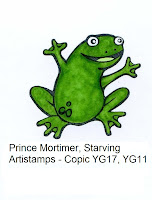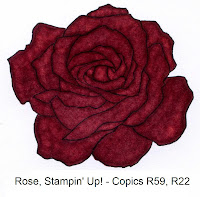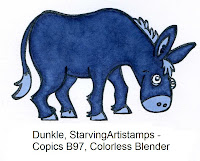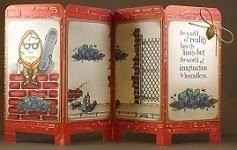
Fading with a Lighter Color has become a favorite Copic technique for some of my students, so I think that it warrants some special attention. This technique allows use of just two Copic markers to create a very soft, velvety, muted color that has plenty of texture and shaded dimension. As you can see in the completed images, the Fading with a Lighter Color technique can be used with a variety of color combinations. I really want for you to try it on your own. It may become one of your favorite ways to use Copics too.

Fill the image first using a very dark color, at least two shades darker than you really want the image to be. A color with a 7 through 9 as the last digit is perfect for this. That last digit indicates the color value (light to dark). A marker color with the last digit as 0 is very pale while a 9 is dark because a lot of gray is added to the color to make it darker.
Choose a lighter color as your fader. A color with the last digit of 5 or lower will work nicely for this. It is not important that this lighter color have the same first digit, just make sure that the last digit is 5 or lower.
While that dark base color is still a little wet, color over it with your lighter color. Begin by holding the brush tip of your lighter color in the center of the image area. Work in small circles that get wider toward the edges of the area. You don’t want to push all of the dark base color outside of the lines of your image so leave a narrow edge of your original color in place around your image lines.

This technique demonstrates the use of a lighter color as a fader. When the tip of the lighter color is used over damp, dark marker color, the wet lighter color will fade the darker color away and allow a very soft, velvety, muted color to show through.

Neat, huh? Let me know if you’ve tried it. Share your images. I’d love to see them. Would you have thought of using this technique if I hadn’t mentioned it? Try using the Colorless Blender as a fader this way too.

















































































2 comments:
It is so neat, seeing what we learned in class, here, and being able to click on the picture and get a close up of what we did and refresh our memories.
I checked out your entire blog, great job, all links work and I think you have all bases covered.
Now you will have to branch off into doing VIDEOS!! I also clicked on Following you, I do follow numerous blogs and I guess I am your first follower :). Will enjoy keeping up with you. See you at the Mauve and Purple class, and I signed up for the makeup Blue class, that is the one I had taken last year, but will refresh my memory this year.
Will email you also,
Terrific Job Rose
Donna
This is my favorite technique to date!
Post a Comment